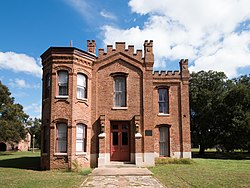United States historic place
| Hammond House | |
| U.S. National Register of Historic Places | |
 | |
 | |
| Location | Bounded by Burnet, China, Elm, and Hanna Sts., Calvert, Texas |
|---|---|
| Coordinates | 30°58′51″N 96°40′13″W / 30.98083°N 96.67028°W / 30.98083; -96.67028 (Hammond House) |
| Area | 2.7 acres (1.1 ha) |
| Built | 1875 |
| Architect | W.T. Ingraham |
| Architectural style | Gothic Revival |
| Part of | Calvert Historic District |
| NRHP reference No. | 70000759 |
| Added to NRHP | October 28, 1970 |
The Hammond House in Calvert, Texas is a two-story Gothic Revival-style building built in 1875. It was listed on the National Register of Historic Places in 1970. It is also included in the National Register-listed Calvert Historic District. The listing includes two contributing buildings.
It was designed by St. Louis architect W.T. Ingraham and has a crenellated parapet.
It is a Recorded Texas Historic Landmark.
It was designed to serve as the courthouse of Robertson County, Texas, but the county seat was moved to Franklin shortly before the building was completed, and it never did serve as a courthouse. The building was documented by the Historic American Buildings Survey. A set of measured drawings was prepared.
References
- ^ "National Register Information System". National Register of Historic Places. National Park Service. November 2, 2013.
- ^ Wayne Bell; Roxanne Williamson (August 7, 1970). "National Register of Historic Places Inventory/Nomination: Hammond House". National Archives. Retrieved May 27, 2018. With five photos. Downloading may be slow.
- "Hammond House, 604 Elm Street, Calvert, Robertson County, TX". Historic American Buildings Survey.
External links
- Hammond House, 604 Elm Street, Calvert, Robertson County, TX, at HABS
 Media related to Hammond House (Calvert, Texas) at Wikimedia Commons
Media related to Hammond House (Calvert, Texas) at Wikimedia Commons
| U.S. National Register of Historic Places | |
|---|---|
| Topics | |
| Lists by state |
|
| Lists by insular areas | |
| Lists by associated state | |
| Other areas | |
| Related | |
This article about a property in Texas on the National Register of Historic Places is a stub. You can help Misplaced Pages by expanding it. |